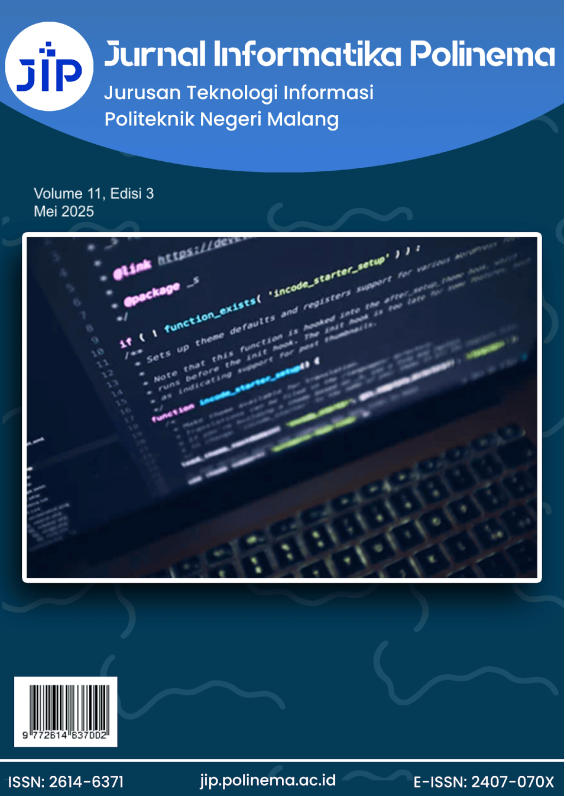Analisis Sentimen Ulasan Pengguna Aplikasi Mobile SP4N-LAPOR! dengan Pendekatan Machine Learning
DOI:
https://doi.org/10.33795/jip.v11i3.7189Keywords:
analisis sentimen, Naive Bayes, NBSVM, N-gram, Support Vector MachineAbstract
Kemajuan teknologi informasi di Indonesia telah mendorong peningkatan akses internet, yang kini mencapai 79,5% dari total populasi. Kondisi ini menciptakan peluang besar bagi digitalisasi layanan publik, termasuk penerapan Sistem Pengelolaan Pengaduan Pelayanan Publik Nasional (SP4N-LAPOR!). Aplikasi ini memungkinkan masyarakat untuk menyampaikan pengaduan dengan cepat dan transparan melalui berbagai platform, termasuk aplikasi mobile. Semakin populernya perangkat mobile semakin memperkuat peran SP4N-LAPOR! dalam mendorong partisipasi masyarakat dalam pengawasan pelayanan publik. Namun, sebagian besar penelitian sebelumnya masih terbatas pada analisis data kualitatif dan kuantitatif deskriptif, sehingga pengalaman serta perspektif pengguna sebagai elemen utama dalam aplikasi ini belum tergambar secara komprehensif. Untuk mengatasi keterbatasan tersebut, penelitian ini mengusulkan penggunaan analisis sentimen terhadap ulasan masyarakat yang diberikan melalui aplikasi mobile berbasis Android. Pendekatan ini bertujuan untuk mengidentifikasi permasalahan teknis serta memberikan gambaran mengenai kualitas layanan yang disediakan oleh penyelenggara. Analisis dilakukan menggunakan teknik Machine Learning dengan tiga model utama: Naive Bayes (NB), Support Vector Machine (SVM), dan kombinasi keduanya (NBSVM) dengan tambahan fitur ekspansi N-gram. Hasil pengujian menunjukkan bahwa model NBSVM memiliki performa terbaik dengan G-Mean sebesar 0.8451, Sensitivity sebesar 0.8227 dan F2 Score sebesar 0.8215, mengungguli model NB dan SVM. Hasil dari penelitian ini diharapkan dapat menjadi alat evaluasi yang efektif bagi penyelenggara pelayanan publik serta memperkuat peran pengawasan Ombudsman RI dalam pelaksanaan SP4N-LAPOR!.
Downloads
References
Abbas, M. et al., 2019. Multinomial Naive Bayes Classification Model for Sentiment Analysis. IJCSNS International Journal of Computer Science and Network Security, 19(3), pp. 62-67.
A'la, F. Y., 2022. Indonesian Sentiment Analysis towards MyPertamina Application Reviews by Utilizing Machine Learning Algorithms. Journal of Informatics Information System Software Engineering and Applications (INISTA), pp. 80-91.
Alqaryouti, O., Siyam, N., Monem, A. A. & Shaalan, K., 2019. Aspect-Based Sentiment Analysis Using Smart Government Review Data. Applied Computing and Informatics.
Awwalu, J., Bakar, A. A. & Yaakub, M. R., 2019. Hybrid N-gram model using Naı¨ve Bayes for classification of political. Neural Computing and Applications.
Chidananda, H. T., Das, D. & Sagnika, S., 2018. Sentiment Analysis Using N-gram. Progress in Computing, Analytics and Networking Advances in Intelligent Systems and Computing 710, pp. 359-367.
Das, M., Selvakumar K. & Alphonse, P., 2021. A Comparative Study on TF-IDF feature Weighting Method and its Analysis using Unstructured Dataset. Kharkiv, Ukraine, COLINS-2021: 5th International Conference on Computational Linguistics and Intelligent Systems.
Faisal, M. R. & Nugrahadi, D. T., 2019. Belajar Data Science: Klasifikasi dengan Bahasa Pemrograman. I ed. Banjarbaru: Scripta Cendekia.
Muhammad, A. N., Bukhori, S. & Pandunata, P., October 16th-17th 2019. Sentiment Analysis of Positive and Negative of YouTube Comments Using Naïve Bayes – Support Vector Machine (NBSVM) Classifier. Jember, Indonesia, IEEE.
Nandwani, P. & Verma, R., 2021. A review on sentiment analysis and emotion detection from text. Social Network Analysis and Mining, Volume 11.
Nawaz, S., 2023. A Comparative Study of Machine Learning Algorithms for Sentiment Analysis. International Journal of Research Publication and Reviews, 4(8), pp. 1999-2003.
Nurandi, 2015. @nurandi. [Online]
Available at: https://www.nurandi.id/blog/membuat-word-cloud-dengan-r/
[Accessed 1 9 2024].
Palomino, . M. A. & Aider, F., 2022. Evaluating the Effectiveness of Text Pre-Processing in Sentiment Analysis. Applied Sciences, Volume 12.
Pang, B., Lee, L. & Vaithyanathan, S., 2002. Thumbs up? Sentiment Classification using Machine Learning Techniques. Philadelphia, Association for Computational Linguistics, pp. 79-86.
Prabowo, R. & Thelwall, M., 2009. Sentiment analysis: A combined approach. J Inform, Volume 3(2), p. 143–157.
Pradyansyach, N. & Yuwono, T., 2023. Analisis Implementasi Pengelolaan Aduan Dan Aspirasi Publik Melalui (Sp4N Lapor) Dalam Mewujudkan Good Governance Di Kabupaten Kendal. Journal of Politic and Government Studies.
Prasetiyo, B., Alamsyah, Muslim, M. A. & Baroroh, N., 2020. Evaluation performance recall and F2 score of credit card fraud detection unbalanced dataset using SMOTE oversampling technique. s.l., IOP Publishing.
Premaiswari, N. M. W., Siregar, R. & Ghazali, R., 2024. The Effectiveness of the SP4N-LAPOR! as a National Public Service Complaint Management Application. JKAP (Jurnal Kebijakan dan Administrasi Publik), p. 36 – 51.
Pusvita, V. & Muttaqin, M., 2023. Satu Dekade LAPOR: Tren Penggunaan Kanal Layanan SP4N A Decade of LAPOR: Usage Trends of SP4N Service Channels. Jurnal_Pekommas, pp. Vol. 8, No. 1: 1–10.
Saputro, H. T. & Hermawan, A., 2021. The Accuracy Improvement of Text Mining Classification on Hospital Review through The Alteration in The Preprocessing Stage. International Journal of Computer and Information Technology, 10(4), pp. 140-146.
Truong, B. et al., 2024. Development and Validation of Machine Learning Algorithms to Predict 1 Year Ischemic Stroke and Bleeding Events in Patients with Atrial Fibrillation and Cancer. Cardiovascular Toxicology, p. 365–374.
Wang, S. & Manning, C. D., 2012. Baselines and Bigrams: Simple, Good Sentiment and Topic Classification, s.l.: Department of Computer Science Stanford University.
Wildhani, A. M., Nurmandi, A., Misran & Subekti, D., 2023. Application of SP4N-LAPOR to Improve the Quality of Public Services and Information (Case Study in Indonesia). Denmark, Springer Nature Switzerland AG, p. 297–305.
Xu, W., Chen, J., Ding, Z. & Wang, J., 2024. Text Sentiment Analysis and Classification Based on Bidirectional Gated Recurrent Units (GRUs) Model. Applied and Computational Engineering, Volume 77, pp. 132-137.












